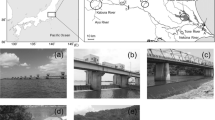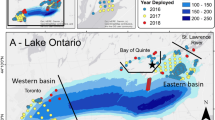Abstract
The Japanese coastlines along the Sea of Japan (Japan Sea) have been thought to be one of the margins of the distribution range of the Japanese eel Anguilla japonica, and there is evidence that eels had naturally recruited into these areas several hundred years ago. However, recruitment there is uncertain recently, because there seems to be no study that reported glass eel or elver recruitment into the coasts along the Japan Sea for a couple of decades, and the eels inhabiting these areas were probably stocked by fisheries cooperatives. In order to improve understanding of the present-day natural geographic distribution range of this species, we searched for naturally recruited wild eels in the Hayase River system, Fukui Prefecture, which flows into the Japan Sea. Multiple approaches including investigation of glass eel recruitment, comparison of body size, and estimation of habitat use types was employed. During the observation period (from January to July 2010), no glass eels were found at the river mouth of the Hayase River in monthly sampling. Of eels collected in this study (n = 127), no eels smaller than the initial body size of eels for stocking were found in this water system and none were identified as being of wild origin based on the habitat use type classifications from otolith microchemistry (n = 48). This lack of evidence of Japanese eels recruiting into Japan Sea coast waters suggests most eels present there may be stocked eels. Japanese eels could have been distributed naturally along the Japan Sea coast more than in recent years, indicating a possible decrease of the natural distribution range of this species.



Similar content being viewed by others
References
Anonymous (1958–2008) Statistical yearbook of ministry of agriculture, forestry and fisheries, ministry of agriculture, forestry and fisheries, Tokyo
Aoyama J (2009) Life history and evolution of migration in catadromous eels (Genus Anguilla). Aqua Biosci Monogr 2:1–42
Aoyama J, Miller MJ (2003) The silver eel. In: Aida K, Tsukamoto K, Yamauchi K (eds) Eel biology. Springer, Tokyo, pp 107–117
Aoyama J, Shinoda A, Yoshinaga T, Tsukamoto K (2012) Late arrival of Anguilla japonica glass eels at the Sagami River estuary in two recent consecutive year classes: ecology and socio-economic impacts. Fish Sci 78:1195–1204
Arai T, Otake T, Tsukamoto K (1997) Drastic changes in otolith microstructure and microchemistry accompanying the onset of metamorphosis in the Japanese eel Anguilla japonica. Mar Ecol Prog Ser 161:17–22
Casselman JM (2003) Dynamics of resources of the American eel, Anguilla rostrata: declining abundance in the 1990s. In: Aida K, Tsukamoto K, Yamauchi K (eds) Eel biology. Springer, Tokyo, pp 255–274
EASEC (2012) Statement of the East Asia Eel Resource Consortium for the protection and conservation of the Japanese eel. Emergency EASEC Symposium, 19 March 2012. http://easec.info/EASEC_WEB/index_files/EASECdeclarations%28Final%29.pdf. Accessed 15 November 2012
Fukuda N, Kuroki M, Shinoda A, Yamada Y, Okamura A, Aoyama J, Tsukamoto K (2009) Influence of water temperature and feeding regime on otolith growth in Anguilla japonica glass eels and elvers: does otolith growth cease at low temperatures? J Fish Biol 74:1915–1933
Han YS, Hung CL, Tzeng WN (2010) Population genetic structure of the Japanese eel Anguilla japonica: panmixia at spatial and temporal scales. Mar Ecol Prog Ser 401:221–232
Kaifu K (2011) Natural resource ecology of Japanese eels in Kojima Bay-Asahi River system, Okayama. Dissertation, The University of Tokyo (in Japanese)
Kaifu K, Tamura M, Aoyama J, Tsukamoto K (2010) Dispersal of yellow phase Japanese eels Anguilla japonica after recruitment in the Kojima Bay-Asahi River system, Japan. Environ Biol Fish 88:273–282
Kaifu K, Miller MJ, Yada T, Aoyama J, Washitani I, Tsukamoto K (2012) Growth differences of Japanese eels Anguilla japonica between fresh and brackish water habitats in relation to annual food consumption in the Kojima Bay-Asahi River system, Japan. Ecol Freshw Fish 22:127–136
Kawakami Y, Mochioka N, Kimura R, Nakazono A (1999) Seasonal changes of the RNA/DNA ratio, size and lipid contents and immigration adaptability of Japanese glass-eels, Anguilla japonica, collected in northern Kyushu, Japan. J Exp Mar Biol Ecol 238:1–19
Kim WS, Yoon SJ, Kim JW, Lee JA, Lee TW (2006) Metabolic response under different salinity and temperature conditions for glass eel Anguilla japonica. Mar Biol 149:1209–1215
Kojima H, Kaifu K, Yokouchi K, Sudo R, Yoshida T, Tsukamoto K, Washitani I (2012) Historical changes of the Japanese eel distribution in the Mikata-Goko Lakes-Hayase River system, Fukui prefecture. Zoo Archaeol 29:1–17 (in Japanese with English abstract)
Kotake A, Okamura A, Yamada Y, Utoh T, Arai T, Miller MJ, Oka H, Tsukamoto K (2005) Seasonal variation in the migratory history of the Japanese eel Anguilla japonica in Mikawa Bay, Japan. Mar Ecol Prog Ser 293:213–225
Matsui I (1972) Eel biology (in Japanese) Kouseisha Kouseikaku, Tokyo
McCleave JD, Robert CK (1982) Selective tidal stream transport in the estuarine migration of glass eels of the American eel (Anguilla rostrata). J Cons int Explor Mer 40:262–271
Miyai T, Aoyama J, Sasai S, Inoue JG, Miller MJ, Tsukamoto K (2004) Ecological aspects of the downstream migration of introduced European eels in the Uono River, Japan. Environ Biol Fish 71:105–114
Nishi T, Kawamura G (2005) Anguilla japonica is already magnetosensitive at the glass eel phase. J Fish Biol 67:1213–1224
Otake T, Ishii T, Nakahara M, Nakamura R (1994) Drastic changes in otolith strontium/calcium ratios in leptocephali and glass eels of Japanese eel Anguilla japonica. Mar Ecol Prog Ser 112:189–193
Tesch FW (2003) The eel biology and management of anguillid eels. Blackwell Publishing, London
Tsukamoto K (1990) Recruitment mechanism of the eel, Anguilla japonica, to the Japanese coast. J Fish Biol 36:659–671
Tsukamoto K (1992) Discovery of the spawning area for Japanese eel. Nature 356:789–791
Tsukamoto K (2009) Oceanic migration and spawning of anguillid eels. J Fish Biol 74:1833–1852
Tsukamoto K, Arai T (2001) Facultative catadromy of the eel Anguilla japonica between freshwater and seawater habitats. Mar Ecol Prog Ser 220:265–276
Tsukamoto K, Aoyama J, Miller MJ (2009) Status of the Japanese eel: resources and recent research. In: Casselman JM, Cairns DK (eds) Eels at the edge: science, status, and conservation concerns. American Fisheries Society Symposium 58, Bethesda, Maryland, pp 21–35
Tsukamoto K, Chow S, Otake T, Kurogi H, Mochioka N, Miller MJ, Aoyama J, Kimura S, Watanabe S, Yoshinaga T, Shinoda A, Kuroki M, Oya M, Watanabe T, Hata K, Ijiri S, Kazeto Y, Nomura K, Tanaka H (2011) Oceanic spawning ecology of freshwater eels in the western North Pacific. Nat Commun 2:1–9
Tzeng WN (1990) Relationship between growth rate and age at recruitment of Anguilla japonica elvers in a Taiwan estuary as inferred from otolith growth increments. Mar Biol 107:75–81
Tzeng WN, Tsai YC (1994) Changes in otolith microchemistry of the Japanese eel, Anguilla japonica, during its migration from the ocean to the rivers Taiwan. J Fish Biol 45:671–683
Yokouchi K, Aoyama J, Oka HP, Tsukamoto K (2008) Variation in the demographic characteristics of yellow-phase Japanese eels in different habitats of the Hamana Lake system, Japan. Ecol Freshw Fish 17:639–652
Yokouchi K, Fukuda N, Miller MJ, Aoyama J, Daverat F, Tsukamoto K (2012) Influences of early habitat use on the migratory plasticity and demography of Japanese eels in central Japan. Estuar Coast Shelf Sci 107:132–140
Acknowledgments
We thank the Torihama, Umiyama, Minami-Saigo, and Mihama Fisheries Cooperatives for their cooperation with this study, and K Kodama and T Maezumi for helping our eel sampling. This work was partly supported by the Environment Research and Technology Development Fund (D-0910) of the Ministry of the Environment, Japan.
Author information
Authors and Affiliations
Corresponding author
Rights and permissions
About this article
Cite this article
Kaifu, K., Maeda, H., Yokouchi, K. et al. Do Japanese eels recruit into the Japan Sea coast?: A case study in the Hayase River system, Fukui Japan. Environ Biol Fish 97, 921–928 (2014). https://doi.org/10.1007/s10641-013-0193-8
Received:
Accepted:
Published:
Issue Date:
DOI: https://doi.org/10.1007/s10641-013-0193-8




